
In this blog, we’ll address the common reasons behind the question, “Why isn’t your optimized page ranking?” and uncover actionable strategies to fix the issues. Whether you’re an SEO veteran or just starting out, understanding the broader SEO landscape is key to improving your rankings. Let’s explore why your page isn’t getting the attention it deserves—and what you can do to turn things around. Your site still needs to rank even though you’ve followed all the rules. You have researched and implemented keywords, optimized your meta tags, and created high-quality content.
There are 16 reasons your page may not rank in search engines, and you can improve it by following these tips:
Indexing and Crawlability Issues
Crawling and indexing, as defined by Google Search Essentials – formerly Webmaster Guidelines – are the fundamental processes that make websites discoverable to search engines.
Indexing and crawling are two different processes. Crawling is how robots search the web for information, whereas indexing refers to building pages that will appear in Google’s results. Indexing and crawling issues can affect page ranking.
1. You have a new website/page.
Your roll should be slow. You’re not ranking your page yet because it is new (especially since it was created recently). Google may take a few days to Index, crawl, and rank your content.
To check whether your site is on Google, you can use “site:yourdomain.com” on Google search (e.g., site:prowebmaster.org). Your website must still be indexed if the search does not return any results.
The Solution
Submit your XML Sitemap to Google Search Console to improve your website’s discoverability. Sitemaps are files that list all of your website’s pages to make it easier for Google and other search engines to crawl them.
Search Console has a URL Inspection tool that you can use to check for crawling issues on your page and correct them.
What is a Sitemap?
Sitemaps can be created using various online generators. Some of the most popular are XML Sitemaps, Yoast SEO (for WordPress users), and XML Sitemaps.
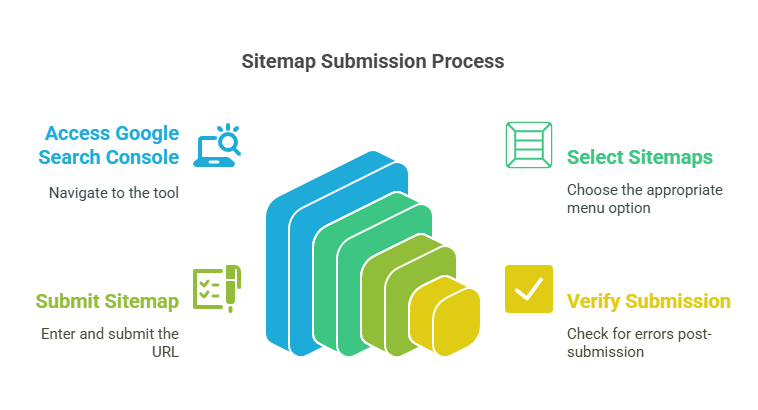
What is Google’s sitemap submission process?
Source: Martindale-Avvo
* Navigate to your website (property) using Google Search Console.
* Select “Sitemaps” under the Index Menu on the left.
* Add your sitemap link (e.g., https://www.yourdomain.com/sitemap.xml) and click “Submit.”
* After submitting the sitemap, verify that there are no errors.
2. Noindex Your content/site
The ‘noindex directive’ is a meta-tag instructing search engine spiders not to index the page or any links. This tag can be added by mistake or accidentally clicked when you set up your website.
Can I use HTML0 to check whether my website has the ‘noindex tag’?
Inspect your website’s source code to see if any pages have been labeled as noindex. The code should be found below the closing tag.
If you use a CMS such as WordPress, the directives for a page can be found in the right window.
Source: Martindale-Avvo
Index, follow, and not Index should be the index status.
Solution
Remove your site’s “noindex” tag to let search engines index it. Request that Google crawl and Index your webpage using the URL Inspection tool.
3. You Are Blocking Google with a Robot.txt file.
The Robots.txt file is located on your web server and tells the search engine which files/folders/pages are available.
The robots.txt is helpful because it prevents sensitive or irrelevant files from appearing in the search engine result pages (SERPs). However, if it’s not configured correctly, Googlebot can block it from indexing your website.
What is the best way to check whether my robots.txt blocks Googlebot?
1. Navigate to Google Search Console to find your property.
2. Select “Coverage” under the Index on the left.
3. Search for URLs that are blocked by robots.txt.
The Solution
If you discover blocked URLs, you can remove lines from your robots.txt. Google offers a guide that shows you how to edit a robots.txt file.
Use the Search Console’s robots.txt test to check if Google can access your page after making the changes.
Technical SEO Problems
Technical Search Engine Optimization optimizes a site’s non-content components (such as codes and settings) for search engine purposes. These are the technical SEO issues that affect your rankings, and how can you fix them?

1. You have a slow page speed (page loading time).
Google also considers page loading speed when ranking websites. Slow webpages can lead to higher bounce rates, lower dwell time, and a negative user experience.
What is the page speed test?
Google PageSpeed Insights can be used to check your site’s loading speed and receive recommendations on how to improve it.
Solution
To improve the page loading speed, use a Content Delivery Network (CDN), optimize your images, and reduce HTTP requests and cache. Consider using accelerated Mobile Pages (AMP) to load your site faster on mobile devices.
3. Your Site Isn’t Mobile-Friendly
Mobile-friendliness has been an essential SEO ranking factor since Google’s Mobile First Indexing 2018 update. Google is now primarily using the mobile version to index and rank pages instead of their desktop versions.
What is the best way to check whether my website has a mobile-friendly design?
Google Mobile-Friendly Test can be used to determine if your site meets Google’s mobile-friendliness criteria.
Solution
If your site is not mobile-friendly, consider using a responsive design or creating a mobile version. Google’s Mobile-Friendly Test can help you find and correct any problems affecting your website’s mobile-friendliness.
4. You’re Being Penalized Because You Went Against Webmaster Guidelines
Google provides guidelines to web admins. If your site violates the guidelines, it may result in a penalty from Google’s algorithms.
Keyword stuffing, purchasing backlinks, and creating spammy/low-quality content are some of the most common offenses.
What is the best way to check whether my website violates webmaster guidelines?
Semrush, Ahrefs, and other SEO tools can identify any problems with your site that may violate Google’s Webmaster Guidelines.
The Solution
Google webmaster guidelines are essential to review and comply with. Follow the Google instructions to ask for reconsideration if you have received a penalty.
Review your site’s SEO technical elements to ensure they align with SEO best practices. You can use SEO tools to evaluate your website’s performance.
5. Your website has security issues.
It is essential to have a secure website for the safety and privacy of your users. This can affect SEO. Google announced that HTTPS (secure hypertext transfer protocol) will now be a ranking element. Websites with SSL certificates are, therefore, likely to have an edge in the search engine results.
What is the best way to check my website for security?
Many web security problems can be detected using free online tools like Google’s Security Issues Report in Search Console. These tools can be scheduled for regular or one-off checks.
The Solution
To create secure connections, use HTTPS rather than HTTP on your site. If you are using WordPress or Joomla, security plugins can increase the security of your site.
Working with a company that offers secure hosting for your website and performs regular security tests can help keep it safe.
Link Building and Backlinking Issues
Google uses links as a ranking factor. Not all links are equal. Having backlinks on low-quality websites or those that spam can harm your ranking.
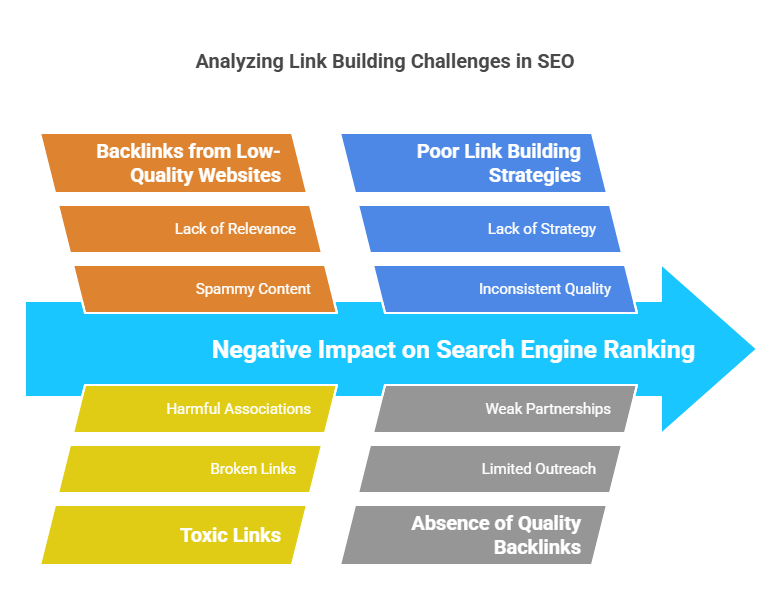
Many common issues with link building can negatively impact your search engine performance.
1. You have broken or toxic links on your site.
Google may penalize your website if it receives toxic or broken backlinks. These are links that point to no longer existing pages or sites.
What is the best way to check whether my website has toxic or broken backlinks?
Use SEO analysis tools like Semrush or Ahrefs to find broken or toxic links on your site.
Solution
Disavow or remove any toxic or broken backlinks. Use the disavow links tool within Search Console to ask Google not to Index or crawl specific links.
2. You’re Not Getting Quality Backlinks to Your Website
To improve your search engine rankings, you need to earn high-quality links from authoritative websites. Getting quality backlinks can be challenging, and you will need the assistance of an SEO specialist.
What is the best way to check the quality of my website backlinks?
SEO tools can assess the quality of backlinks using factors such as domain authority, relevancy, and other metrics.
The Solution
You can also contact relevant websites and ask them to link to your content. Contact relevant websites to ask for links to your content. You can earn high-quality backlinks by building relationships with bloggers and influencers in your field.
3. You need a better internal linking structure on your site.
A well-organized system for internal links helps search engines better understand the importance and hierarchy of pages on your site. Pages with more links are deemed more important and will appear higher in the search engine results.
The Solution
Add internal links strategically to important pages and posts on your site. Ensure your links are related and relevant and add value for users.
Use SEO tools like Screaming Frog and Sitebulb to audit your website’s internal linking. Use relevant anchor text and link all pages to improve the user experience.
An expert in technical SEO will also help you optimize your site’s internal link structure for better search engine rankings.
Content and Keyword-Related Issues
Your site’s content is the foundation and is essential in ranking factors. Google evaluates the quality of your content based on three key factors: relevance, keyword optimization, and quality.

1. Keyword Cannibalization on Your Site
When multiple pages of your site compete with each other for the same topic or keyword, this is called “keyword cannibalization.” Search engines can be confused, and these pages may not rank well.
Solution
Combine or merge similar pages to create a primary page. Canonical tags can be used to specify the URL preferred for a specific keyword or topic.
Ensure your content is unique and well-organized to avoid the cannibalization of keywords across multiple pages.
2. You are not optimizing your website’s content for target keywords.
Search engines need to understand your topic and the relevance of your content. Overstuffing content with keywords may hurt rankings.
To achieve the best results, keywords should also be placed in your title tags, headings, meta descriptions, and content.
What is the best way to check that the content on my website has been optimized with target keywords?
Use SEO tools to check the keyword placement and density of your content.
The HTML0 Solution
Use keywords that are relevant to your content and have low competition. These keywords should be used naturally in your content without being overused.
For optimal keyword optimization, include your primary and secondary keywords throughout your content, including headings and meta descriptions.
3. You Are Not Giving Value To Your Users
Google prioritizes content that is valuable and relevant to users. If your content does not have a user-centric focus, you may waste time and money on unusable content.
The Solution
Produce high-quality, informative, and engaging content that provides value for your users. Ensure your content answers your audience’s questions or helps them solve their problems.
What is the best way to check whether my content provides value?
Content value can be determined by metrics such as time spent on the page, bounce rates, and social sharing. Track these metrics using analytics tools such as Google Analytics and adapt your content strategy.
4. You have duplicate content on your website.
The term duplicate content describes large blocks of identical or appreciably alike content found within or between domains. Duplicate content can be unintentional due to technical problems or intentional through practices such as content scraping, where content is taken from one site and posted on another without permission.
Duplicate content is a problem for SEO, as it can lower rankings.
What is the best way to check for duplicate content on my website?
Use SEO tools like Siteliner Copyscape and Semrush to check your site for duplicate content. These tools compare your website content with that of other web pages, allowing you to detect duplication easily.
The Solution
To resolve duplicate content problems, you first need to identify and remove or modify any content that appears on your website. This could involve rewriting the content, consolidating similar pages, or using 301 redirects to your preferred version.
Canonical tags can be used when duplicate content cannot be avoided (for example, product descriptions on an eCommerce site).
The canonical tag tells search engines which URL version to display as a search result, thus preventing negative SEO effects from multiple versions.
Google SEO Algorithm Changes and Penalties
Keeping up with Google’s SEO algorithm updates can take time and effort. Adapting and staying updated with these changes can help you keep ahead of your competition and retain your search ranking.
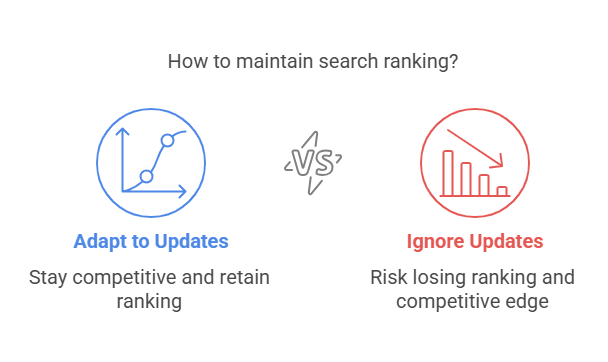
1. Google Algorithm Updates Affect You
Google’s search algorithms aim to enhance the user experience through relevant and high-quality results. Google’s algorithm updates can affect how your website ranks in the search results. Depending on how your website adheres to new ranking criteria, it could decrease or increase.
The Solution
Keep up to date with Google algorithm changes and adapt your SEO strategy. Google’s official blog announces significant algorithm updates, such as Panda, Penguin, or Hummingbird, while more minor changes can be made without any announcement.
2. Google Has Penalized You
Google penalties can cause a drop in search ranking. This can be due to a number of reasons, such as black-hat SEO techniques like buying links or keyword stuffing or violating Google webmaster guidelines.
Solution
Stay up-to-date on Google’s algorithms and follow SEO best practices to avoid penalties. You can identify issues and correct them before your ranking is negatively affected by regular SEO audits and troubleshooting.
You can request reconsideration of the penalty from Google after you’ve resolved the issue.
How Do You Know if Your Content/Site Is Performing Well in the First Place?
User engagement metrics indicate the level to which your content is engaging your audience. A high bounce rate, for example, could indicate that your content does not meet users’ expectations and does not provide value.
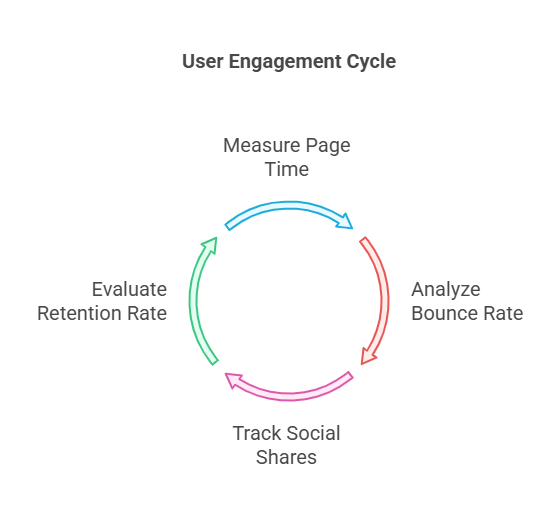
You can track the following metrics:
Page Time: The time a visitor spends at your site before leaving.
* % of visitors who abandon your website after only viewing one page
Social shares: Number of social shares on platforms such as Facebook, Twitter, and LinkedIn.
Retention rate: Percentage of visitors returning to your website after the initial visit.
How Can You Track User Engagement Metrics?
You can track and analyze user engagement metrics on your website using tools like Google Analytics. Hotjar and Crazy Egg. These metrics can provide valuable insight into how users engage with your website and how you might improve it.
Does your optimized page still need to run well?
Even though you followed our guide to the letter, your page still needs to rank better on search engines. Your site needs to be optimized by professionals!
While it is possible to optimize your site yourself, you may need the help of an SEO specialist.
Animations Software Internet Marketing Agency is a leading SEO agency that offers detailed technical audits and solutions to businesses looking to boost their rankings.
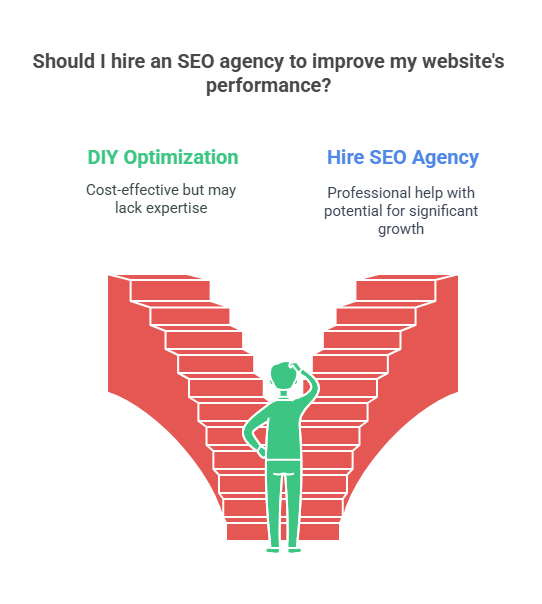
Our local SEO strategies are designed to help you reach long-term success.
Take it from Geoforce, the leading cloud-based asset-tracking platform provider.
The company hired Animations Software to improve SEO and social media performances. They achieved great results with a hands-on, more active approach:
* Increase in Organic Traffic by 360% YoY
* a 88% rise in clicks on ads and a 121% growth in Instagram followers
An increase of 352% in Facebook Impressions
* 100 Increase in LinkedIn Followers


